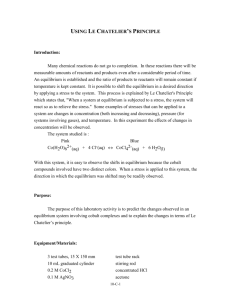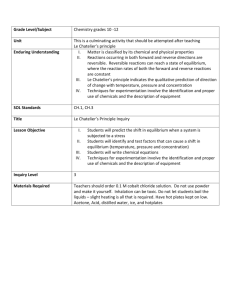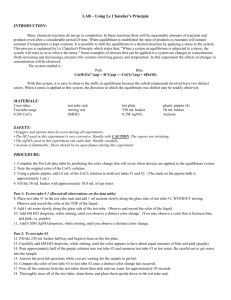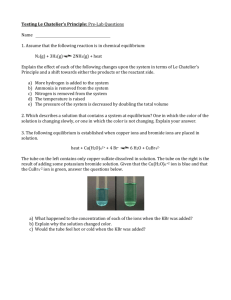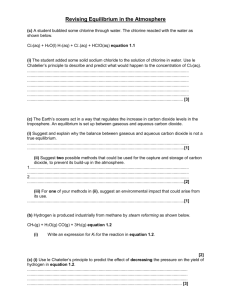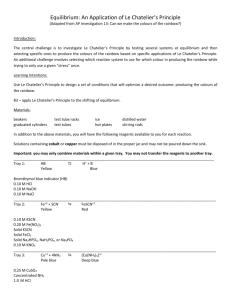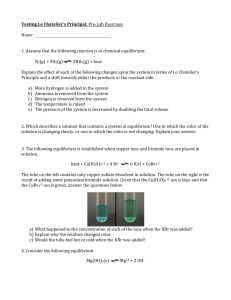Using Le Chatelier*s Principle
advertisement
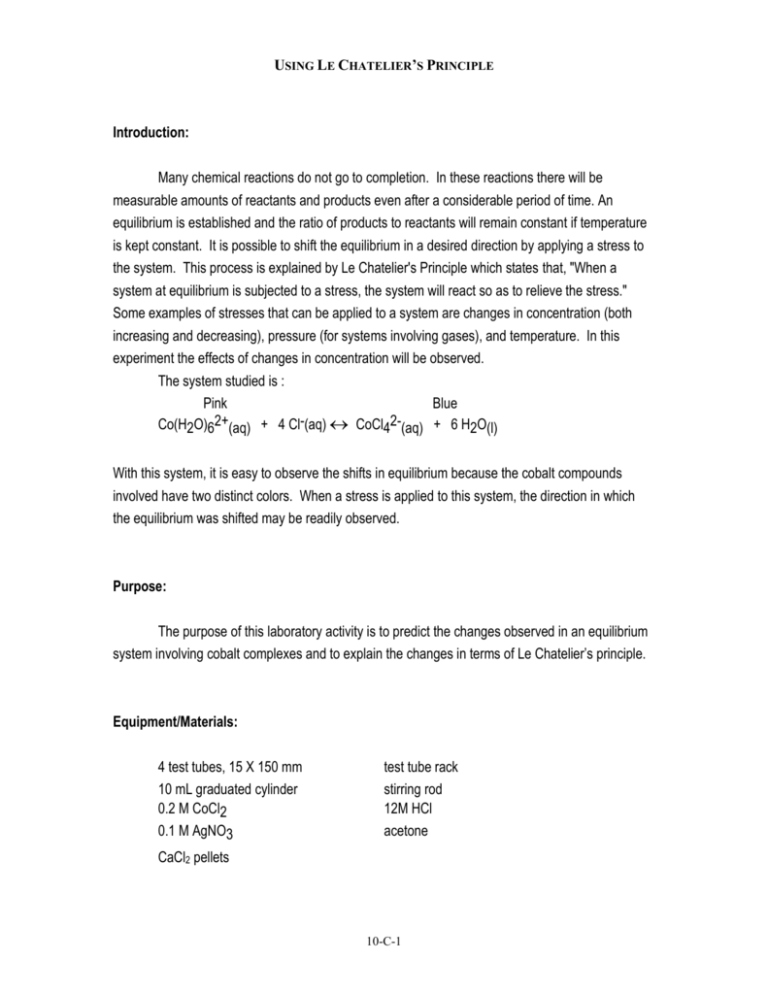
USING LE CHATELIER’S PRINCIPLE Introduction: Many chemical reactions do not go to completion. In these reactions there will be measurable amounts of reactants and products even after a considerable period of time. An equilibrium is established and the ratio of products to reactants will remain constant if temperature is kept constant. It is possible to shift the equilibrium in a desired direction by applying a stress to the system. This process is explained by Le Chatelier's Principle which states that, "When a system at equilibrium is subjected to a stress, the system will react so as to relieve the stress." Some examples of stresses that can be applied to a system are changes in concentration (both increasing and decreasing), pressure (for systems involving gases), and temperature. In this experiment the effects of changes in concentration will be observed. The system studied is : Pink Blue 2+ 2Co(H2O)6 (aq) + 4 Cl (aq) CoCl4 (aq) + 6 H2O(l) With this system, it is easy to observe the shifts in equilibrium because the cobalt compounds involved have two distinct colors. When a stress is applied to this system, the direction in which the equilibrium was shifted may be readily observed. Purpose: The purpose of this laboratory activity is to predict the changes observed in an equilibrium system involving cobalt complexes and to explain the changes in terms of Le Chatelier’s principle. Equipment/Materials: 4 test tubes, 15 X 150 mm 10 mL graduated cylinder 0.2 M CoCl2 0.1 M AgNO3 test tube rack stirring rod 12M HCl acetone CaCl2 pellets 10-C-1 Safety: Goggles and an apron must be worn during all experiments. The HCl used in this experiment is very corrosive. Handle with caution. The vapors are irritating. The AgNO3 used in this experiment can stain skin. Handle carefully. Acetone is flammable. There should be no open flames during this experiment. Procedure: 1. Before beginning the experiment, complete Section 1 of the data page. This section asks one to predict the changes that will occur when changes (stresses) are made to the equilibrium system. 2. Label four test tubes 1-4 with labeling tape. Add 2mL of CoCl2 solution to test tube 1. Add 2mL of the CoCl2 solution into test tube 2. Add 5mL of the CoCl2 to test tube 3. Add 5mL of CoCl2 to test tube 4. 3. Under a fume hood, carefully add 2 droppers full of concentrated (12M) HCl into test tube 1. Stir the contents gently and record observations in Section 2 of the data table. 4. Pour half of the contents of test tube 1 into test tube 4. 5. Add 7 mL of deionozed water to test tube 1. Stir the contents and record observations in the data table. 6. Add 10 drops of 0.10 M AgNO3 to test tube 4. Stir the contents gently, and record the results in the data table. 7. Tilt test tube 2 and gently pour 1-2 droppers full of acetone down the side of the test tube to avoid mixing the acetone and the cobalt solution. This step will not work unless the acetone remains in a separate layer. Record results on the data table. 8. To the third test tube add 5-10 small pellets of calcium chloride. Record your observations. 10-C-2 Name ________________________________Date___________________Hour_______ USING LE CHATELIER’S PRINCIPLE Data Table: Section 1: Refer to the equation of the reaction being studied and answer the questions in this section before beginning the experiment. Pink Blue 2+ 2Co(H2O)6 (aq) + 4 Cl (aq) CoCl4 (aq) + 6 H2O(l) Predict the affect the following changes have on the equilibrium system: 1. Adding HCl, a source of Cl- ions 2. Adding H2O 3. Adding silver nitrate, AgNO3 (Silver ions and chloride ions react to form an insoluble precipitate.) 4. Adding acetone (Acetone is often used by chemists to remove the last traces of water from glassware.) 5. Adding calcium chloride 10-C-3 Section 2: Observation Table Step Procedure Observations HCl added H2O added AgNO3 added Acetone added CaCl2 added Questions: 1. In step 3, hydrochloric acid is used as a source of Cl- ions. Explain the observations in terms of Le Chatelier’s principle. 2. In step 5, why did the addition of H2O cause the change that it did? Explain the observations in terms of Le Chatelier’s principle. 3. In step 6, silver ions from the AgNO3 react with Cl- ions to produce an insoluble precipitate. Use this information and Le Chatelier’s principle to explain the observations. 4. Acetone has an attraction for H2O. Use this fact and Le Chatelier’s principle to explain the observations resulting from step 7. 10-C-4 USING LE CHATELIER’S PRINCIPLE TEACHER NOTES Lab Time: 20 minutes Preparations: Time: 20 minutes. T: Make available a set of equipment and materials for each lab group. T: Prepare 0.2 M CoCl2 The 0.2 M cobalt solution is prepared by dissolving 4.8 g of CoCl2.6H2O per 100 mL of solution. T: Prepare 0.1 M AgNO3. The silver nitrate solution requires 1.7 g of AgNO3 per 100 mL of solution. V: The van can supply any materials, including solutions, as requested. Answers to Questions: 1. In step 3, hydrochloric acid is used as a source of Cl- ions. Explain the observations in terms of Le Chatelier’s principle. Chloride ion is on the left side of the equation. Adding it shifts the equilibrium to the right side (blue). 2. In step 5, why did the addition of H2O cause the change that it did? Explain the observations in terms of Le Chatelier’s principle. Water is on the right side of the equation. Adding it shifts the equilibrium to the left side(pink). 10-C-5 3. In step 6, silver ions from the AgNO3 react with Cl- ions to produce an insoluble precipitate. Use this information and Le Chatelier’s principle to explain the observations. Chloride ion is on the left side of the equation. Removing it shifts the equilibrium to the left (pink). 4. Acetone has an attraction for H2O. Use this fact and Le Chatelier’s principle to explain the observations resulting from step 7. Water is absorbed by the acetone layer. Removing water shifts the equilibrium to the right (blue). Considerations: This is a semi-quantitative experiment. The quantities used do not have to be precise. When dividing solutions, the volumes do not have to be exactly the same in order to get good results. It is not necessary in this lab to spend undue time measuring the reagents. This lab works best when using concentrated (12 M) HCl. It is probably best to measure the samples and pour them in the hood for the students. This also allows for better monitoring of spills. There are many ways in which to use an experiment in a curriculum. This one has been used successfully many times immediately after a discussion of Le Chatelier’s principle. The vivid color changes make it very easy to actually "see" a shift in equilibria. This activity is adapted from Chemistry: A Modern Course, Merrill Publishing Co., 1987. Last updated 8-01 10-C-6
